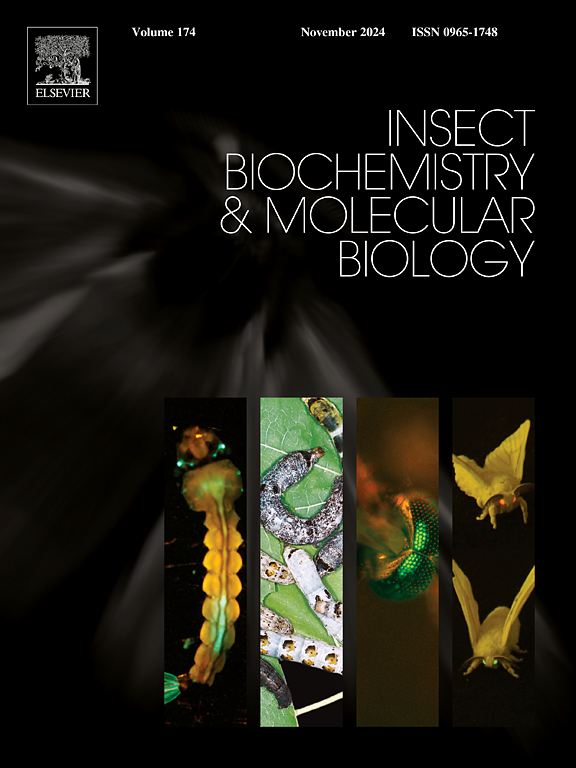Transcriptomic and proteomic analyses reveals the diverse venom composition of the spider Neoscona shillongensis
IF 3.7
2区 农林科学
Q2 BIOCHEMISTRY & MOLECULAR BIOLOGY
引用次数: 0
Abstract
Neoscona shillongensis (Araneidae), also known as the Shillong orb-weaving spider, is a species that constructs a typically shaped round web, is inactive during the daytime and comes out at dusk to forage, primarily preying on flying insects such as mosquitoes, flies, and moths. This spider serves as an important natural enemy of agricultural and forest pests. Neoscona shillongensis primarily uses its web to capture prey, but its venom also plays a crucial role in subduing and processing prey. To date, no research has been conducted on the composition of N. shillongensis venom. In This study, conducted high-throughput sequencing on the venom gland transcriptome and the venom gland extract proteome. A cDNA library of the venom gland tissue of N. shillongensis was constructed, yielding over 62 million reads, which were assembled into 90,481 sequences, predicting 171 toxin-like sequences, including 94 peptide toxins and 77 protein toxins. Furthermore, proteomic analyses of the venom gland extract samples identified 53 peptides and proteins, including 23 peptide toxins and 30 enzymes or proteins such as acetylcholinesterase, hyaluronidase, and astacin-like metalloproteases. The results revealed that the toxin composition of N. shillongensis is diverse and complex. This study provides essential baseline data for further research on the evolution and physiological activity of spider venom, as well as the potential development of pharmaceutical compounds therefrom.

转录组学和蛋白质组学分析揭示了蜘蛛Neoscona shillongensis的多种毒液组成。
Neoscona shillongensis(蜘蛛科),也被称为Shillong圆织蜘蛛,是一种构造典型形状的圆形蛛网的物种,白天不活动,黄昏时出来觅食,主要捕食蚊子,苍蝇和飞蛾等飞行昆虫。这种蜘蛛是农业和森林害虫的重要天敌。Neoscona shillongensis主要用它的网捕捉猎物,但它的毒液在制服和处理猎物方面也起着至关重要的作用。到目前为止,还没有对西隆蛇毒液的成分进行过研究。本研究对蛇毒腺转录组和蛇毒腺提取物蛋白质组进行了高通量测序。构建了shiillongensis蛇毒腺组织cDNA文库,全长6200万条,共组装成90481条序列,预测了171条毒素样序列,其中94条为肽毒素,77条为蛋白毒素。此外,对蛇毒腺提取物样本进行蛋白质组学分析,鉴定出53种肽和蛋白质,包括23种肽毒素和30种酶或蛋白质,如乙酰胆碱酯酶、透明质酸酶和astastin样金属蛋白酶。结果表明,西隆芽孢杆菌毒素组成多样、复杂。该研究为进一步研究蜘蛛毒液的进化和生理活性,以及蜘蛛毒液药物化合物的潜在开发提供了必要的基础数据。
本文章由计算机程序翻译,如有差异,请以英文原文为准。
求助全文
约1分钟内获得全文
求助全文
来源期刊
CiteScore
7.40
自引率
5.30%
发文量
105
审稿时长
40 days
期刊介绍:
This international journal publishes original contributions and mini-reviews in the fields of insect biochemistry and insect molecular biology. Main areas of interest are neurochemistry, hormone and pheromone biochemistry, enzymes and metabolism, hormone action and gene regulation, gene characterization and structure, pharmacology, immunology and cell and tissue culture. Papers on the biochemistry and molecular biology of other groups of arthropods are published if of general interest to the readership. Technique papers will be considered for publication if they significantly advance the field of insect biochemistry and molecular biology in the opinion of the Editors and Editorial Board.

 求助内容:
求助内容: 应助结果提醒方式:
应助结果提醒方式:


